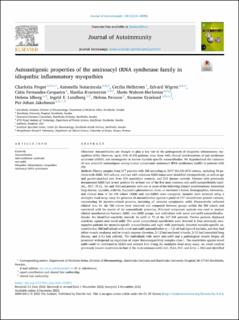| dc.description.abstract | Objectives: Autoantibodies are thought to play a key role in the pathogenesis of idiopathic inflammatory myopathies (IIM). However, up to 40% of IIM patients, even those with clinical manifestations of anti-synthetase syndrome (ASSD), test seronegative to known myositis-specific autoantibodies. We hypothesized the existence of new potential autoantigens among human cytoplasmic aminoacyl tRNA synthetases (aaRS) in patients with IIM.
Methods: Plasma samples from 217 patients with IIM according to 2017 EULAR/ACR criteria, including 50 patients with ASSD, 165 without, and two with unknown ASSD status were identified retrospectively, as well as age and gender-matched sera from 156 population controls, and 219 disease controls. Patients with previously documented ASSD had to test positive for at least one of the five most common anti-aaRS autoantibodies (anti-Jo1, -PL7, -PL12, -EJ, and -OJ) and present with one or more of the following clinical manifestations: interstitial lung disease, myositis, arthritis, Raynaud's phenomenon, fever, or mechanic's hands. Demographics, laboratory, and clinical data of the IIM cohort (ASSD and non-ASSD) were compared. Samples were screened using a multiplex bead array assay for presence of autoantibodies against a panel of 117 recombinant protein variants, representing 33 myositis-related proteins, including all nineteen cytoplasmic aaRS. Prospectively collected clinical data for the IIM cohort were retrieved and compared between groups within the IIM cohort and correlated with the results of the autoantibody screening. Principal component analysis was used to analyze clinical manifestations between ASSD, non-ASSD groups, and individuals with novel anti-aaRS autoantibodies.
Results: We identified reactivity towards 16 aaRS in 72 of the 217 IIM patients. Twelve patients displayed reactivity against nine novel aaRS. The novel autoantibody specificities were detected in four previously seronegative patients for myositis-specific autoantibodies and eight with previously detected myositis-specific autoantibodies. IIM individuals with novel anti-aaRS autoantibodies (n = 12) all had signs of myositis, and they had either muscle weakness and/or muscle enzyme elevation, 2/12 had mechanic's hands, 3/12 had interstitial lung disease, and 2/12 had arthritis. The individuals with novel anti-aaRS and a pathological muscle biopsy all presented widespread up-regulation of major histocompatibility complex class I. The reactivities against novel aaRS could be confirmed in ELISA and western blot. Using the multiplex bead array assay, we could confirm previously known reactivities to four of the most common aaRS (Jo1, PL12, PL7, and EJ (n = 45)) and identified patients positive for anti-Zo, -KS, and -HA (n = 10) that were not previously tested. A low frequency of anti-aaRS autoantibodies was also detected in controls.
Conclusion: Our results suggest that most, if not all, cytoplasmic aaRS may become autoantigenic. Autoantibodies against new aaRS may be found in plasma of patients previously classified as seronegative with potential high clinical relevance. | en_US |

